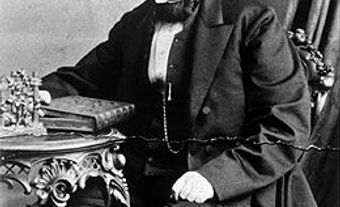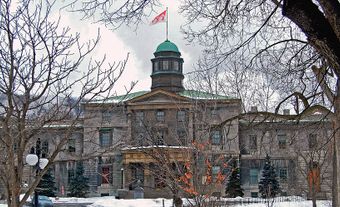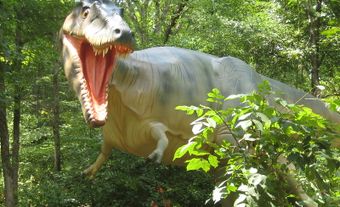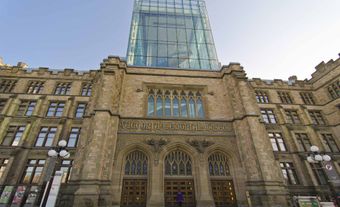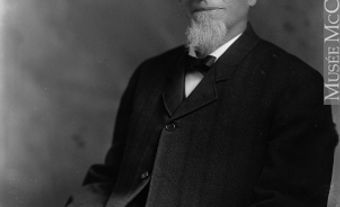The Redpath Museum is a natural history museum located on the grounds of McGill University, in Montreal, Quebec. Founded in 1882, it is the first purpose-built museum in Canada and one of the oldest continually operating museums in the country. The Redpath’s expansive collection is divided into four broad groups: mineralogy, palaeontology, zoology and world cultures (ethnology). (See also Minerals; Anthropology in Canada.) The collections are housed in a stand-alone museum building of Greek Revival style (see Architecture). In addition to its public education function, the Redpath is an integrated component of McGill University’s Faculty of Science, complete with research labs and undergraduate and graduate courses that make use of the museum’s ample collections.

History
Founded in 1882, the Redpath Museum is one of the oldest museums in Canada. The museum was built with funds donated by Peter Redpath, a prominent Montreal businessman of the mid-to late 19th century, and the owner of Redpath Sugar. Initially, the museum was built specifically to house the large collection amassed by McGill University’s enterprising principal, John William Dawson. Dawson was an avid naturalist and arguably Canada’s first scientist of international reputation. The museum was commissioned in 1880 to mark the 25th anniversary of Dawson’s tenure as principal of the university.

Since its establishment, the Redpath Museum’s public facing role has shifted. As a university museum with a comprehensive research and teaching collection, the Redpath Museum’s primary purpose was to serve the educational and research needs of McGill University’s students and faculty. By 1952, the museum expanded its programming for elementary and high school students of the Montreal area. Public access was reduced in the 1970s for financial reasons but returned in the mid-1980s. Collections-based research, public and post-secondary education remain priorities for the museum.
Architecture
The Redpath Museum was designed in a Greek Revival style by Alexander Denton Steele and Alexander Cowper Hutchison of the architectural firm, Hutchison and Steele (see Architecture). The site chosen for the museum, at the top of what was then McGill University’s cricket field, was deliberate. This area of the field was a prominent location on the university’s campus. It also could be seen from Sherbrooke Street, which by the 1880s was becoming a fashionable street in the city’s upscale Square Mile neighbourhood. Dawson and Hutchison wanted the Redpath Museum to have a strong “Grecian” style, which they felt was well-suited to a university campus. The facade of the building was constructed with strong and distinctive Greek Revival features, including Corinthian-inspired columns and a raised portico. The Redpath Museum reflects a combination of different architectural styles, which are reflective of a Victorian preference for classical styles. As such, it is an atypical design that blends different classical styles yet also matches the more uniformly designed buildings around it. The building is described as featuring both North American and European influences and sharing in both modern and traditional architectural traditions. It is also one of the first Canadian buildings to be praised for its architecture at an international level.

The museum was designed specifically to serve as a university museum that would have three distinct functions: collection storage, exhibitions, and university teaching and research. These three functions were considered in the architectural design and decoration of the museum. A raised basement was constructed for storage. The main floor’s semicircular auditorium and laboratories were reserved for teaching and research. The uppermost levels, distinguished by clerestory windows, were used for the display of specimens.
Did you know?
The Redpath’s world cultures collection contains roughly 2,500 objects from Africa, 2,000 objects from Ancient Egypt (including three mummies), 3,500 objects representing ancient Greece and Rome, 800 objects from Oceania, 600 from South America, a unique collection of 350 medical containers and implements from 15th century Sri Lanka and another 3,000 objects representing Palaeolithic Europe and the near East.
Collections
The Redpath Museum has a collection of approximately 3 million objects, including examples of extinct animals. The museum also has the second-largest collection of Egyptian artifacts in Canada. In addition, the Redpath has as an impressive assemblage of minerals and fossils, including specimens of the earliest known vertebrates. The collection also includes taxidermal animals from across Quebec and around the world.
The zoology collection includes 10,000 vertebrates and 14,000 invertebrate specimens (which include bones, taxidermy, skins and shells). The collection also includes the bones of a minke whale and a Japanese spider crab. The zoology collection also features specimens of animals native to Quebec and Eastern Canada. Endangered species, like the wolf, gorilla and lion, as well as extinct species, like the Carolina parakeet and the passenger pigeon also comprise the collection. The museum also has the bones of the extinct Steller’s sea cow.

Did you know?
Ornithology, the study of birds, is a discipline of zoology. The Redpath Museum’s zoology collection preserves approximately 1,500 bird specimens for research and study purposes.
The Redpath Museum has a large mineralogy collection. Over 20,000 specimens makeup the collection. Minerals from all over the world, including Quebec are part of the collection. The mineralogy collection also includes the personal collection of John William Dawson and other 19th century scientists who taught at McGill University.

The palaeontology collection contains a complete skeleton of Gorgosaurus libratus, a dinosaur that was a relative of Tyrannosaurus Rex (see Dinosaurs in Canada). The skeleton is currently on display in the museum’s central gallery. Also included in the palaeontology collection are 30,000 specimens of invertebrate Ordovician fossils from the St. Lawrence Lowlands, the oldest known terrestrial vertebrate fossils (found at Joggins, Nova Scotia) and marine mammals of the Pleistocene Era from the Champlain Sea (see Ice Age). The collection also includes all the fossilized plants collected by Dawson.
The Redpath’s world cultures collection is also extensive, with about 17,000 ethnological and archaeological artifacts from all corners of the globe. The museum’s Canadian history collection, including First Nations artifacts, was turned over in 1970 to the McCord Museum, which specializes in Canadian history. Initially, the archaeological and ethnological collections were considered to be of secondary importance to the museum’s natural history collections. This eventually changed. The Redpath Museum’s world cultures collection gradually expanded to include ethnology and archaeology artifacts originally held by the Natural History Society of Montreal and the McGill Ethnographical Museum. The diverse array of objects in the world cultures collection includes: coins, pottery, textiles, weapons, ornaments, basketry, lamps, bronze figures, hieroglyphic texts, ceremonial objects, tools, musical instruments and masks.

 Share on Facebook
Share on Facebook Share on X
Share on X Share by Email
Share by Email Share on Google Classroom
Share on Google Classroom
